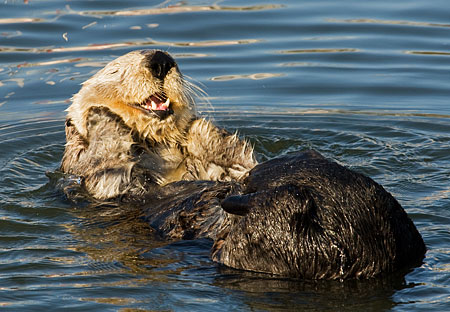Otters primarily eat fish and crustaceans. They also consume insects, small mammals, and birds.
Otters are playful creatures with an appetite that leans heavily towards aquatic delicacies. Their dining preferences include fish such as trout and perch, and they relish a variety of crustaceans like crabs and crayfish. As carnivorous mammals, otters exhibit opportunistic feeding behaviors, often broadening their menu to include amphibians, waterfowl, and small terrestrial animals when available.
Their strong webbed feet and agile bodies allow them to be proficient hunters in water environments, while their sensitive whiskers aid in detecting prey. Remarkably adaptive, otters balance their diet with local ecological offerings, ensuring they uphold their position as skilled predators within diverse ecosystems. As top predators in their habitat, otters play a significant role in maintaining the balance of aquatic food chains.
Varieties Of Otter Species
Otters exhibit a diverse dietary palette that adapts to their environment. Freshwater otters primarily thrive on fish and small aquatic invertebrates. They leverage their agility in water to chase and catch their prey stealthily. On the other coast, sea otters are known for their remarkable use of rocks to break open shellfish. Their diet consists largely of sea urchins, crabs, mussels, and sometimes small fish.
The giant otters, an impressive species in size, have an appetite to match. They hunt in groups and can take down sizable catches like anacondas and piranhas. Lastly, the Eurasian otters maintain a diverse menu, ranging from fish to small birds, amphibians, and crustaceans. Their habitat across Europe and Asia provides them with a rich variety of prey to choose from.
Freshwater Otters’ Daily Diet
Freshwater otters have a diverse diet that primarily consists of fish. These agile swimmers are well-adapted to catching a variety of fish species, which serve as their main source of sustenance. Their typical hunting technique involves stealth and speed, as they navigate through water with ease. Fish are high in protein and essential fatty acids, making them an ideal meal for these energetic mammals.
Beyond fish, freshwater otters also indulge in crustaceans, including crayfish and crabs. These creatures, found along the riverbed, add important nutrients to the otter’s diet. Additionally, otters occasionally consume aquatic plants; these plants provide fiber and other nutrients, though they make up a smaller portion of the diet compared to animal prey.
Sea Otters’ Feeding Habits
Sea otters are renowned for their diverse diet but show a strong preference for shellfish. Notably, they have an appetite for sea urchins and clams, which they skillfully crack open using rocks as tools. This unique feeding technique is not only fascinating but also a testament to the otter’s intelligence and adaptability.
These marine mammals are often observed floating on their backs, deftly handling their meals with dexterous paws. The sea otter’s diet not only provides essential nutrients but also plays a crucial role in the ecological balance of their habitat, as their predation helps control the sea urchin population, which can otherwise overrun kelp forests and decimate this vital ecosystem.
Giant Otters: Apex Predators
Giant Otters, occupying the apex position in their food chain, showcase remarkable hunting skills. Preferring calm and shallow waters, these agile predators primarily target large fish species such as piranhas and catfish. Their acute senses and powerful bodies allow them to swiftly capture these substantial aquatic creatures with remarkable efficiency.
Beyond their fish-centric diet, Giant Otters occasionally turn their attention to smaller reptiles. Opportunistic by nature, they adeptly catch various reptiles like snakes and caimans, supplementing their nutritional intake and maintaining their position at the top of the food web. Their diverse dietary habits reflect their adaptability and prowess within their freshwater habitats.
Eurasian Otters’ Varied Menu
Eurasian otters showcase a varied diet that prominently includes a range of fish species. Their aquatic feasts often consist of common carp, perch, pike, and salmon, chosen not just for availability but also nutritional value. Predation on fish takes into account factors like size, abundance, and ease of capture. A noteworthy aspect of the otter’s hunting behavior is their adaptability and opportunism in feeding habits.
Beyond the fish, their diet is supplemented by other aquatic creatures such as frogs and even birds. This addition of amphibians and avian prey provides a balanced nutrition, ensuring that the otters maintain their health across seasonal changes when certain prey might be less available. Thus, the Eurasian otters maintain a flexible and diverse diet to thrive in their habitats.

Credit: www.aquariumofpacific.org
Diving And Foraging Skills
Otters are adept at hunting in aquatic environments, utilizing their highly developed ability to search underwater. Their foraging skills are incredibly sophisticated; with a combination of sensitive whiskers and agile movements, otters can locate and capture prey in murky waters where visibility is low. Their diet primarily consists of fish, but they also consume amphibians, crustaceans, and mollusks.
Astonishingly, otters are one of the few tool-using mammal species, employing rocks as tools to access food. By smashing hard shells against rocks or using them as anvils, otters are able to crack open the protective exteriors of shellfish. This behavior highlights their intelligence and adaptability, showcasing their remarkable survival strategies in the wild.
Collaborative Hunting Strategies
Otters form collaborative groups to optimize their hunting efforts. These groups, often comprising family members, work in unison to corral schools of fish or other prey into compact areas, making them easier to catch. This technique not only reflects their intelligence but also their social nature. Engaging as a coordinated team, they display sophisticated behaviors that contribute to their survival.
Their pups are not born with an innate ability to hunt, so adult otters invest time in teaching their young. Through observational learning and direct participation, pups gradually learn to master the skills necessary for effective hunting. This tutelage is essential for their eventual independence and ability to contribute to the group’s hunting success.
Impact On Aquatic Life
Otters play a crucial role in aquatic ecosystems by regulating fish populations. By preying on various fish species, they help maintain a balance in the aquatic environment, which can prevent any single species from dominating and disrupting the ecological harmony. Their diet consists largely of fish, which they hunt with remarkable dexterity using their agile bodies and sharp senses.
Their foraging habits contribute to influencing species diversity. Otters’ predation patterns can encourage a healthy variety of species by preventing overpopulation of certain fish while giving lesser-known species a chance to flourish. This effect can cascade through the food chain, fostering a robust and vibrant aquatic community.
Interactions With Human Activities
Otters play a dual role in their ecosystems and in their interactions with human activities. Acknowledged for being natural pest controllers, they consume various aquatic organisms that are considered pests. These include crabs and snails, which might negatively affect other wildlife or human concerns in certain contexts.
However, tension arises with the fishing industry, where otters are often seen as competitors. They target fish stocks, some of which are earmarked for commercial fishing. This competition can lead to economic losses for fishermen as they compete with otters for the same resources. Managing this conflict necessitates innovative solutions that balance environmental conservation with human economic interests.
Dietary Essentials For Health
Otters require a diet high in protein and fat to sustain their energetic lifestyle. These aquatic mammals predominantly consume fish, but their diet also includes crustaceans, mollusks, and occasionally small amphibians and birds. The high protein content is crucial for muscle repair and growth, while fats provide a dense source of energy and help to maintain their insulating fur.
A varied diet is not only essential for providing a balanced intake of nutrients but also for preventing dietary deficiencies. Otters in captivity have been observed to suffer health issues if their diet lacks variety, so wildlife caretakers strive to mimic the diversity found in an otter’s natural foraging. Ensuring these dietary essentials for health is paramount in maintaining both the physical and psychological well-being of otters.
Human Impacts On Otter Food Sources
Otters rely on a rich and diverse diet, but overfishing has become a significant threat to their food sources. The depletion of fish stocks due to intensive fishing practices means otters face increasingly scarce prey in their natural habitats. This reduction in available food can lead to competition with fishermen, causing increased human-otter conflict.
Pollution and habitat loss further compound the issue. Industrial waste, agricultural run-off, and urbanization lead to the degradation of water bodies. The resulting contaminated and reduced aquatic environments pose serious risks to otter populations by affecting both the quantity and quality of their food supply. These factors combined can result in altered feeding behaviors and may threaten the survival of otter species worldwide.
Frequently Asked Questions For What Do Otters Eat
What Is The Primary Diet Of Otters?
Otters primarily dine on fish, making it the staple of their diet. However, they also enjoy a variety of other aquatic foods like crustaceans, mollusks, and sometimes small amphibians and birds.
Do Otters Eat Plants Or Vegetation?
No, otters are mainly carnivorous and do not typically eat plants. They focus on hunting for meat-based food like fish, shellfish, and other small aquatic animals for nutrition.
How Do Otters Catch Their Prey?
Otters are skilled swimmers, using their agility and dexterity in water to chase and catch prey. They have sensitive whiskers to detect movements of prey in murky waters and sharp claws for gripping.
Can Otters Eat Non-aquatic Animals?
While they prefer aquatic food, some otter species will occasionally eat small terrestrial animals, such as birds or rodents, if aquatic prey is scarce.
Conclusion
Exploring the diet of otters reveals a fascinating world where these playful mammals thrive. Their tastes span a diverse range from fish to crustaceans, each vital to their survival and well-being. As we protect their habitats, we ensure these delightful creatures continue to enchant us with their antics and appetite.
Remember, preserving ecosystems benefits otters and the rich menu nature provides for them.

